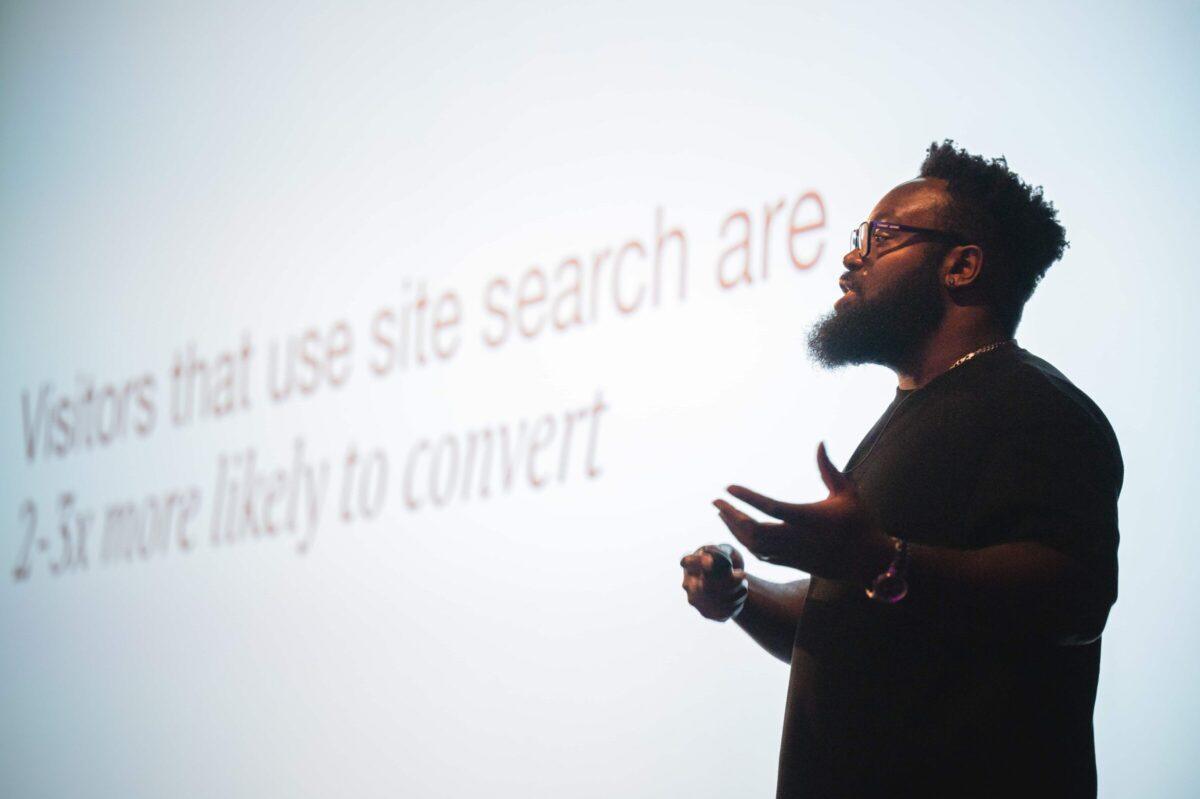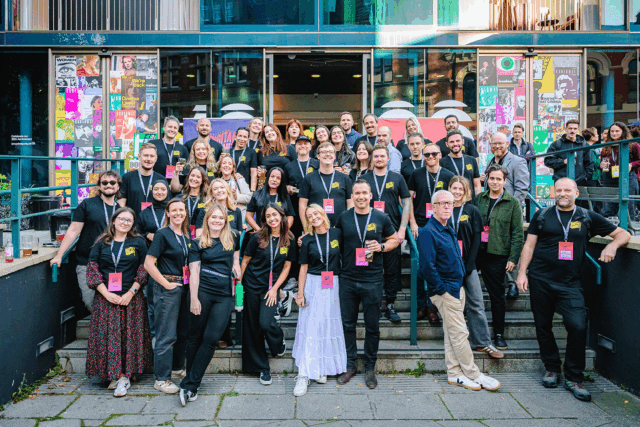I’ll begin with a small act of sacrilege. Then I’ll end with a big note of hope.
So here we go: the grand divide between B2B and B2C marketing is largely a myth. An old, cardigan-wearing, spreadsheet-wielding, deeply convenient myth.
Sure, the journeys look different. Yes, B2B involves procurement goblins, labyrinthine security questionnaires and finance people who interrogate VAT with the steely gaze of a detective in a Scandi noir. But these quirks do not change the underlying laws of marketing. They never have.
But to break down these perceived walls, we’re going to need to contemplate the simple truth: the human beings who buy enterprise software, insurance platforms, or machinery are the same human beings who buy shampoo, coffee and luxury watches. They do not switch off their emotional circuitry at 9am and become hyper-rational drones.
Which is why the only meaningful lens isn’t B2B vs B2C. It’s business to humans.
B2B has spent too long using perceived differences as a shield. “Our buyers are rational.” “Our product is too complex for emotion.” “We’re not shampoo.” “Our buying cycle is far too long.”
But this isn’t marketing exceptionalism, it’s marketing timidity. Because the laws that build brilliant consumer brands are exactly the same ones that build brilliant B2B brands. The difference, if any, is execution, not exemption.
Now I will immediately contradict myself, but there is rationale to it.
All categories are different – that’s the point
When someone declares that B2B is “different,” what they usually mean is that their category has quirks. And of course it does, because every category under the sun does. That’s what makes the world a fascinating place.
Within B2C alone, FMCG moves at breakneck speed with colossal reach, where brutal rules of distribution and physical availability dominate. Luxury industries rely on desirability of a different kind, scarcity and theatre. Automotive plays a long, considered game. And yet they all operate under the same laws: build mental availability, create distinctive assets, forge emotional connection, sustain it over time.
B2B and its glorious subcategories that make the backbone of our economy follow a similar path. Selling cloud software isn’t the same as selling industrial equipment. Cybersecurity isn’t HR services. Each of these categories has its own pace, language, anxieties, buying triggers and rituals, but none of them are exempt from the fundamentals.
The era of digital dominance has intensified this truth, not erased it. Each category uses digital differently – FMCG lives in reach and frequency, luxury trades in storytelling and craft, B2B leans heavily on targeted reach and lead generation – but the rules are the same underneath. If you don’t build a brand that lives in someone’s head, your digital tactics are just noise. B2B’s mistake has been to confuse category nuance with strategic exemption. To treat dashboards as oracles, rather than tools.

How we got here: A culture of small thinking
To understand how this myth calcified, we need to look at how B2B marketing grew up. So I will give you a theory. Unlike its glamorous consumer cousin, B2B didn’t emerge from the world of brand campaigns and cultural storytelling. It was forged in the functional, fluorescent-lit backrooms of sales and product departments, like a scene from Tinker Tailor Soldier Spy – grey-brown suits, too many ashtrays.
First came product orientation: “We’ve built something clever. People will obviously want it.” Marketing existed, if at all, merely to avoid the oil on the floor and tidy up after the engineers. The product was the hero; the customer? An afterthought.
Then came sales orientation: quarterly targets, pipeline dashboard and marketing as a polite footnote at the end of the deck. Brand became decorative garnish. “Fluff,” as it was so often called.
What never fully took root was market orientation – the radical notion that in B2B marketing, too, should start with the customer, not the pipeline. Consumer brands made that leap decades ago. They understood that the best product doesn’t always win. The most memorable, salient and emotionally resonant one does.
B2B, meanwhile, built itself a story, the kind of narrative an Adam Curtis documentary would eviscerate: a story of rational buyers making rational decisions.
Throw in complex products, and categories that are simply too serious for this flakey emotion nonsense, we spawned an entire culture of whitepapers, feature lists, cautious language and stock photos of people pointing earnestly at laptops. Without the customer-focussed nuance, there was no positioning; proper targeting and segmentation was reduced to fantastical personas and ICPs. Creativity? Forget it.
So this is my take on how the myth entrenched itself. It began with product worship, hardened under sales control and never quite shook off the belief that marketing should be sensible, serious and… beige.
But for some B2B companies, the myth lingers because it’s useful. Calling B2B “different” is a marvellous safety blanket across an organisation. It justifies the current work. It keeps the peace with Sales. It allows Marketing to be a service department rather than the strategic engine that it should be. It excuses the lack of ambition.
Such a way of thinking also fits neatly into the short-term performance dashboard. Emotional brand building is difficult to measure in a neat quarterly report, despite the acreage of published marketing science, so it’s quietly ignored – perhaps unintentionally.
Worst of all, I’m convinced this is all self-perpetuating. If you believe your category is boring, you’ll make boring work. That boring work will fail to cut through. And that failure will confirm your belief that B2B is boring. A perfect little loop.
But none of this changes the laws of marketing. It never did.
The laws don’t change
| Marketing Principle | B2C | B2B |
| Build mental availability | ✅ | ✅ |
| Create emotional connections | ✅ | ✅ |
| Distinctive brand assets matter | ✅ | ✅ |
| Consistency over time | ✅ | ✅ |
| Category Entry Points drive growth | ✅ | ✅ |
By the way there’s no secret clause at the bottom of this table saying except if you sell SaaS.
Research from LinkedIn B2B Institute shows that 95% of B2B buyers are out of market at any given time. Brand building is what gets remembered when they are ready.
The Institute of Practitioners in Advertising found that B2B brand campaigns drive up to three times more long-term business effects than activation alone.
And Ehrenberg-Bass Institute for Marketing Science has shown repeatedly that brands with strong mental availability win disproportionately.
The principles are fixed. The execution flexes. That’s simply how marketing works.
Emotion isn’t optional – it’s amplified
One of the most persistent bedtime stories in B2B is that business buyers are rational. That because they’re spending company money, they’re immune to the emotional currents shaping every other decision they make in their lives.
Nah, I’m not having that.
B2B decisions are often more emotional than consumer ones. If a chocolate bar disappoints (I’m grumbling specifically at those brands that have now replaced proper cocoa with spurious “chocolate flavouring”) you grumble and move on. Forget to buy a tin of beans? Your stroppy kid will moan at you that night, but what’s new there?
Choose the wrong SaaS platform and your entire department spends six months trapped in an administrative purgatory.
Fear, trust, reputation and herd behaviour weigh heavily on these supposedly rational decisions. The higher the stakes, the stronger the emotional undercurrent.
That’s why brands like Salesforce, IBM and Mailchimp loom so large. They don’t rely on clever feature lists alone – they’ve built trust and familiarity long before the buying window ever opens. (As an aside, did anyone actually get fired for buying IBM?)

Owning the Day One list
Every buying journey starts with a moment.
“We’ve just raised funding.” “Our compliance is a mess.” “The CFO wants better reporting.”
These moments are known as Category Entry Points – the triggers that bring a brand to mind. And here’s the brutal truth: if your brand isn’t already on the buyer’s Day One list when those moments hit, you’ve lost before the race begins. There’s no point pressing against the office windows with your whitepaper at this stage.
B2B isn’t a gentle jog around an empty park. It’s trench warfare conducted in polite voices with HR looking over your shoulder. Decision cycles are long, risk tolerance is low. Nobody wakes up desperate to hear from you.
The brands that win aren’t those shouting frantically at the finish line. They’re the ones whispering intelligently for months, sometimes years, beforehand. They’ve laid the groundwork, lodged their name in memory, and earned trust well before anyone starts Googling.
Consumer brands fight for slivers of attention in loud, crowded markets. B2B faces something harder: silence. Indifference.
The invisible wall of “maybe later”, which only encourages desperation down the line. Which is why the few who plant their flag early carve out spaces that no algorithm can touch.
The real enemy: Fear
If the rules are the same, why hasn’t B2B had its creative renaissance yet?
Fear.
Fear of not looking serious. Fear of annoying Sales. Fear of not proving ROI tomorrow morning. Fear of humour, of colour, of emotion because it’s not what we’ve done before.
And so campaigns are sanded down until they resemble laminated spec sheets – tidy, sensible and utterly forgettable – but the B2B brands that are starting to win are the ones that embrace emotional and creative storytelling. They are investing in salience. They are prepared play the long game in the most creative ways possible.
Pipeline panic vs marketing ecosystems
Here’s where this all lands in practice.
If you’re worrying about your pipeline, the answer isn’t to hurl more digital tactics at the problem like confetti at a wedding. Tactical activity has its place, of course – but it’s no substitute for building on strategic marketing.
Real marketing in B2B isn’t a tap you turn on when the numbers wobble. It’s an ecosystem that looks, ideally, to the long-term as well as short at the same time. One that builds salience, trust and emotional familiarity long before a buyer even starts sniffing around for options.
If you focus only on short-term tactics, you’re constantly playing catch-up, reacting to the market rather than shaping it. Strategic brand building makes your brand present before the conversation even begins, gets you found before the search begins. It’s the quiet work that ensures, when a need finally arises, your name surfaces first – naturally, almost effortlessly. People get you, notice you, recall you, like what you’re saying, and think of you when they’re ready to enter the market.
This is how consumer brands operate instinctively. FMCG doesn’t panic every quarter because the long-term brand work does its job. Luxury doesn’t flood the internet with retargeting campaigns to keep the pipeline warm. They know that brand creates flow. B2B must learn the same lesson.
When a brand is built properly, pipeline anxiety doesn’t need patching. It recedes.
Business to human
Behind every B2B job title sits a person. Someone scrolling LinkedIn over a Pret sandwich at lunch, and then Instagram later that night. If they expect connection, wit and beauty as consumers, why would they tolerate beige at work?
The difference between FMCG, luxury, B2B tech or industrial components isn’t whether marketing works. It isn’t who does digital or who does out of home. It’s how the brand shows up. Category differences shape execution, not the laws. The humans on the receiving end remain gloriously, predictably… well, human.
This is why the “Business to Human” framing matters. It dissolves the false boundary and puts the focus where it belongs: on people. Real, breathing, emotional people who need to trust you before they’ll buy from you.
B2B marketers have an extraordinary advantage here. Most of their competitors aren’t doing this well. The upside for those who do is disproportionate. The brands that invest in emotional storytelling, creative ideas and consistent presence will look like pioneers in a few years’ time.
You have permission to:
• Invest in brand
• Make people feel something
• Run dazzling creative work that builds mental availability
• Speak to humans, not just functions
• Think long term
The notion that B2B should play by different rules has held the sector back for decades.
Every category is different – within B2C, even within B2B. That’s what makes marketing interesting. But no category is exempt. The principles are universal, the expression contextual.
When brands grasp that – truly grasp it – everything changes. Budgets stop being spent on panic campaigns and start building something enduring. Brands stop shouting at the finish line and start whispering long before the race begins. Marketing stops being a service function and becomes the strategic engine it should have always been.

When two become one…
There aren’t two sets of laws – one for B2C and one for B2B. There’s just marketing. To humans.
The context may shift, the committees may multiply, the procurement goblins may appear with their spreadsheets. But at the end of the day, it’s still human beings making decisions.
B2B doesn’t need to reinvent the wheel to be radical. No, to be radical it needs to accept the laws, and apply them with craft and courage.
So if there is a difference between B2B and B2C marketing, and I suppose really I should highlight one at the end of 2,000 words, it’s this.
Because of a category blandness that is generally absent in B2C, because of the cultural legacy that keeps most B2B brands rather tame, for any brands who make this leap – to acknowledging that this is simply marketing, built on strategic, human-focussed, creative first thinking…
The rewards are going to be vast.
Everything has been left on the table.
The brands that get this right will define the next generation of B2B powerhouses. Looking to become one of those B2B brands? Let’s talk.





